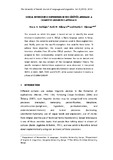| dc.description.abstract | The research on which this paper is based set out to identify the sexual
intercourse euphemisms used in Gĩkũyũ, a Bantu language spoken in Kenya,
then discuss the semantic and lexical processes used in those euphemisms,
and, finally, point out the specific metaphors that underlie these latter. To
achieve these objectives, the research used data collected (using an
interview schedule) from 20 native Gĩkũyũ speakers. The euphemisms were
assigned to their corresponding semantic and lexical processes, and then
discussed in terms of their correspondences between the source domain and
target domain, two key concepts of the Conceptual Metaphor Theory. The
specific metaphors behind those euphemisms were discussed. It transpired
from this discussion that men generally looked at sexual intercourse more as
WORK, A GAME, WAR, FOOD and UTILITY, while women looked at it mainly as
a form of COMPANIONSHIP. | en_US |

